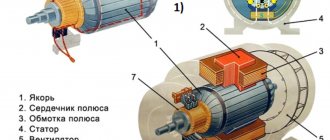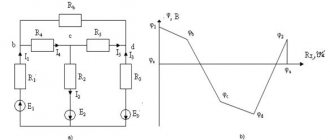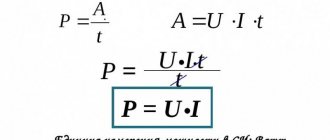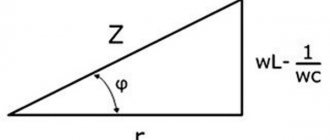Work of the electrostatic field
Let's consider the situation: charge q0 enters an electrostatic field. This electrostatic field is also created by some charged body or system of bodies, but we are not interested in this. A force acts on the charge q0 from the field, which can do work and move this charge in the field.
The work of the electrostatic field does not depend on the trajectory. The work done by the field when a charge moves along a closed path is zero. For this reason, the electrostatic field forces are called conservative
, and the field itself is called
potential
.
Potential difference. Voltage
Work done by electrostatic field forces to move charge q
0 from point
1
to point
2
of the field
\(~A_{12} = W_{1} - W_{2} .\)
Let us express the potential energy in terms of the field potentials at the corresponding points:
\(~W_{1} = q_0 \cdot \varphi_1 , W_{2} = q_0 \cdot \varphi_2 .\)
Then
\(~A_{12} = q_0 \cdot (\varphi_1 — \varphi_2) .\)
Thus, the work is determined by the product of the charge and the potential difference between the starting and ending points.
From this formula, the potential difference
\(~\varphi_1 — \varphi_2 = \dfrac{A_{12}}{q_0} .\)
- The potential difference
is a scalar physical quantity, numerically equal to the ratio of the work of field forces to move a charge between given points of the field to this charge.
The SI unit of potential difference is the volt (V).
- 1 V is the potential difference between two such points of the electrostatic field, when a charge of 1 C is moved between them by field forces, work of 1 J is performed.
The potential difference, unlike the potential, does not depend on the choice of the zero point. The potential difference φ1 - φ2 is often called electrical voltage
between these points of the field and denote
U
:
\(~U = \varphi_1 - \varphi_2 .\)
- The voltage
between two points of the field is determined by the work of the forces of this field to move a charge of 1 C from one point to another.
The work done by electric field forces is sometimes expressed not in joules, but in electron volts
.
- 1 eV is equal to the work done by field forces when moving an electron ( e
= 1.6 10-19 C) between two points, the voltage between which is 1 V.
1 eV = 1.6 10-19 C 1 V = 1.6 10-19 J. 1 MeV = 106 eV = 1.6 10-13 J.
Potential
The "charge - electrostatic field" or "charge - charge" system has potential energy, just as the "gravitational field - body" system has potential energy.
A physical scalar quantity characterizing the energy state of the field is called potential
a given point in the field. A charge q is placed in a field, it has potential energy W. Potential is a characteristic of an electrostatic field.
Let's remember potential energy in mechanics. Potential energy is zero when the body is on the ground. And when a body is raised to a certain height, it is said that the body has potential energy.
Regarding potential energy in electricity, there is no zero level of potential energy. It is chosen randomly. Therefore, potential is a relative physical quantity.
In mechanics, bodies tend to occupy a position with the least potential energy. In electricity, under the influence of field forces, a positively charged body tends to move from a point with a higher potential to a point with a lower potential, and a negatively charged body, vice versa.
Potential field energy is the work done by the electrostatic force when moving a charge from a given point in the field to a point with zero potential.
Let us consider the special case when an electrostatic field is created by an electric charge Q. To study the potential of such a field, there is no need to introduce a charge q into it. You can calculate the potential of any point in such a field located at a distance r from the charge Q.
The dielectric constant of the medium has a known value (tabular) and characterizes the medium in which the field exists. For air it is equal to unity.
1.4. Working in an electric field. Potential
When a test charge q moves in an electric field, electric forces do work. This work for small displacement is equal to (Fig. 1.4.1):
| Figure 1.4.1. Work of electric forces with small charge movement q |
Let us consider the work of forces in an electric field created by a distributed charge that does not change in time, i.e. electrostatic field
The electrostatic field has an important property:
The work of electrostatic field forces when moving a charge from one point in the field to another does not depend on the shape of the trajectory, but is determined only by the position of the starting and ending points and the magnitude of the charge.
The gravitational field also has a similar property, and this is not surprising, since gravitational and Coulomb forces are described by the same relations.
A consequence of the independence of work from the shape of the trajectory is the following statement:
The work done by the electrostatic field forces when moving a charge along any closed trajectory is zero.
Force fields that have this property are called potential or conservative.
In Fig. Figure 1.4.2 shows the Coulomb field lines of a point charge Q and two different trajectories of movement of a test charge q from the starting point (1) to the ending point (2). A small displacement is highlighted on one of the trajectories. The work ΔA of the Coulomb forces on this displacement is equal to
Thus, work at small displacement depends only on the distance r between the charges and its change Δr. If this expression is integrated over the interval from r = r1 to r = r2, then we can obtain
| Figure 1.4.2. The work of Coulomb forces when moving a charge q depends only on the distances r1 and r2 of the initial and final points of the trajectory |
The obtained result does not depend on the shape of the trajectory. On trajectories I and II shown in Fig. 1.4.2, the work of the Coulomb forces is the same. If on one of the trajectories the direction of movement of the charge q is changed to the opposite, then the work will change sign. It follows that on a closed trajectory the work of Coulomb forces is equal to zero.
If the electrostatic field is created by a set of point charges, then when a test charge q moves, the work A of the resulting field, in accordance with the superposition principle, will be the sum of the work of the Coulomb fields of point charges: Since each term of the sum does not depend on the shape of the trajectory, then the total work A of the resulting field does not depends on the path and is determined only by the position of the starting and ending points.
The property of potentiality of an electrostatic field allows us to introduce the concept of potential energy of a charge in an electric field. To do this, a certain point (0) is selected in space, and the potential energy of the charge q placed at this point is taken equal to zero.
The potential energy of a charge q placed at any point (1) in space relative to a fixed point (0) is equal to the work A10 that the electrostatic field will perform when moving charge q from point (1) to point (0):
| Wp1 = A10. |
(In electrostatics, energy is usually denoted by the letter W, since the letter E denotes field strength.)
Just as in mechanics, potential energy is determined up to a constant value, depending on the choice of the reference point (0). Such ambiguity in the definition of potential energy does not lead to any misunderstandings, since the physical meaning is not the potential energy itself, but the difference in its values at two points in space.
The work done by the electrostatic field when moving a point charge q from point (1) to point (2) is equal to the difference in the potential energy values at these points and does not depend on the path of charge movement and on the choice of point (0).
| A12 = A10 + A02 = A10 – A20 = Wp1 – Wp2. |
The potential energy of a charge q placed in an electrostatic field is proportional to the magnitude of this charge.
A physical quantity equal to the ratio of the potential energy of an electric charge in an electrostatic field to the value of this charge is called the potential φ of the electric field:
Potential φ is an energy characteristic of an electrostatic field.
The work A12 does to move electric charge q from the starting point (1) to the ending point (2) is equal to the product of the charge and the potential difference (φ1 – φ2) of the starting and ending points:
| A12 = Wp1 – Wp2 = qφ1 – qφ2 = q(φ1 – φ2). |
In the International System of Units (SI), the unit of potential is the volt (V).
| 1 V = 1 J / 1 C. |
In many problems of electrostatics, when calculating potentials, it is convenient to take the point at infinity as the reference point (0). In this case, the concept of potential can be defined as follows:
The field potential at a given point in space is equal to the work done by electric forces when removing a unit positive charge from a given point to infinity.
The potential φ∞ of the field of a point charge Q at a distance r from it relative to a point at infinity is calculated as follows:
As follows from Gauss's theorem, the same formula expresses the field potential of a uniformly charged ball (or sphere) for r ≥ R, where R is the radius of the ball.
For a visual representation of the electrostatic field, along with lines of force, equipotential surfaces are used.
A surface at all points of which the electric field potential has the same values is called an equipotential surface or a surface of equal potential.
Electrostatic field lines are always perpendicular to equipotential surfaces.
The equipotential surfaces of the Coulomb field of a point charge are concentric spheres. In Fig. 1.4.3 shows pictures of field lines and equipotential surfaces of some simple electrostatic fields.
| Figure 1.4.3. Equipotential surfaces (blue lines) and field lines (red lines) of simple electric fields: a – point charge; b – electric dipole; c – two equal positive charges |
In the case of a uniform field, equipotential surfaces are a system of parallel planes.
If the test charge q made a small movement along the field line from point (1) to point (2), then we can write:
| ΔA12 = qEΔl = q(φ1 – φ2) = – qΔφ, |
where Δφ = φ1 – φ2 – change in potential.
It follows that this relation in scalar form expresses the relationship between field strength and potential. Here l is the coordinate measured along the field line.
From the principle of superposition of field strengths created by electric charges, the principle of superposition for potentials follows:
| φ = φ1 + φ2 + φ3 + … |
How to determine the sign of potential
When solving problems, a lot of confusion arises when determining the sign of potential, potential difference, and work.
The figure shows tension lines. At which point in the field is the potential greater?
The correct answer is point 1. Let us remember that the tension lines begin on a positive charge, which means the positive charge is on the left, therefore the leftmost point has the maximum potential.
If a field is being studied that is created by a negative charge, then the field potential near the charge has a negative value; this can be easily verified if a charge with a minus sign is substituted into the formula. The further away from the negative charge, the greater the field potential.
If a positive charge moves along the tension lines, then the potential difference and work are positive. If a negative charge moves along the tension lines, then the potential difference has a “+” sign, and the work has a “-” sign.
Think for yourself: the work and potential difference will take negative or positive values if the charge is moved in the opposite direction relative to the tension lines.
Potential difference and tension
Let's calculate the work done by the forces of the electrostatic field when moving an electric charge q
0 from a point with potential φ1 to a point with potential φ2 of a uniform electric field.
On the one hand, the work of field forces \(~A = q_0 \cdot (\varphi_1 - \varphi_2)\).
On the other hand, the work of moving charge q
0 in a uniform electrostatic field \(~A = q_0 \cdot E \cdot \Delta x\).
Equating the two expressions for work, we get:
\(~q_0 \cdot (\varphi_1 - \varphi_2) = q_0 \cdot E \cdot \Delta x, \;\; E = \dfrac{\varphi_1 - \varphi_2}{\Delta x},\)
where Δ x
— projection of displacement onto the power line.
This formula expresses the relationship between the intensity and potential difference of a uniform electrostatic field. Based on this formula, you can set the SI unit of tension: volt per meter (V/m).
Potential energy of interaction of point charges
Just as any body that interacts with the Earth according to the law of universal gravitation has different potential energy at different distances from its center, an electric charge q at different distances from another charge q0 has different potential energy - W. If a charge q moves in an electric field from point 1, where its potential energy was W1, to point 2, where its energy became W2, the work of field forces A = W1 - W2 = -(W2 - W1) = -ΔW. As can be seen from the formula, A and ΔW have opposite signs. This is explained by the fact that if the charge q moves under the influence of field forces (i.e. the work of the field A is positive), then its potential energy decreases, the energy increase ΔW is negative. If the charge moves against the field forces (A is negative), then the potential energy of the charge increases. (Same relationship between potential energy and work done by gravity.)
Since the letter E indicates the strength of the electric field, energy in electrodynamics is usually denoted by the letter W.
As is known, the value of potential energy depends on the choice of the zero level. In electrostatics, it is agreed that the potential energy of a charge placed at a point infinitely distant from a charged body creates a field, considered zero, W∞ = 0. Then, in the case of moving charge q from point 1 to infinity, the work of the field A = W1 - W∞ = W1. That is, the potential energy of a charge q placed at any point in the field is numerically equal to the work that the field forces do, moving this charge from a specified point to infinity: W = qEd, where d is the distance from the field source to the point at which it is located charge q.
In electrical engineering, in contrast to electrostatics, zero is often taken to be the potential energy of a charge placed on the Earth.
If the field is created by a positive charge, then the potential energy value of another positive charge placed at some point in this field will be positive, but if the field is created by a negative charge, then the potential energy value of the positive charge will be negative. For a negative charge placed in an electric field, everything will be the opposite. When a field is created by several charges at once, the potential energy of a charge q placed at any point in such a field is equal to the algebraic sum of the energies due to the field of each charge at this point.











